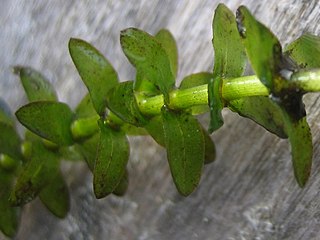
Elodea is a genus of 6 species of aquatic plants often called the waterweeds described as a genus in 1803. Classified in the frog’s-bit family (Hydrocharitaceae), Elodea is native to the Americas and is also widely used as aquarium vegetation and laboratory demonstrations of cellular activities. It lives in fresh water. An older name for this genus is Anacharis, which serves as a common name in North America.

Vallisneria is a genus of freshwater aquatic plant, commonly called eelgrass, tape grass or vallis. The genus is widely distributed in tropical and subtropical regions of Asia, Africa, Europe, and North America.

Lycopodium clavatum is the most widespread species in the genus Lycopodium in the clubmoss family.

Elodea canadensis is a perennial aquatic plant, or submergent macrophyte, native to most of North America. It has been introduced widely to regions outside its native range and was first recorded from the British Isles in about 1836.

Anubias is a genus of aquatic and semi-aquatic flowering plants in the family Araceae, native to tropical central and western Africa. They primarily grow in rivers and streams, but can also be found in marshes. They are characterized by broad, thick, dark leaves that come in many different forms. The genus was revised in 1979 and since then its nomenclature has been stable. Species can be determined by using mostly characteristics of the inflorescence. Because of the often shady places where the plants grow, the genus was named after the Egyptian god Anubis, the god of the afterlife. The genus was first described in 1857 by Heinrich Wilhelm Schott, with A. afzelii as its type species.
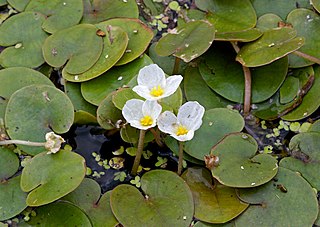
Hydrocharis is a genus of aquatic plants in the family Hydrocharitaceae described as a genus by Carl Linnaeus in 1753. It is widespread across much of Europe and Asia, plus a few scattered locations in Africa. It is also reportedly naturalized in parts of North America.

Echinodorus berteroi is an aquatic plant species in the Alismataceae It is native to the southern and central parts of the United States, as well as Central America, the West Indies, and South America as far south as Argentina.

Vallisneria americana, commonly called wild celery, water-celery, tape grass, or eelgrass, is a plant in the family Hydrocharitaceae, the "tape-grasses". V. americana is a fresh water species that can tolerate salt, living in salinities varying from fresh water to 18 parts per thousand, although the limit to the salt tolerance is unclear, and is generally dependent on the duration and intensity of the plants’ exposure to the saline water. V. americana is a deep rooted plant with leaves, approximately one inch wide, with the ability to rise two or more meters above the clustered base of the plant. Contrary to the implications of one of its common names, wild celery bears little to no resemblance to the celery used as a vegetable. V. americana grows under water and is consumed by various animals, including the canvasback. The plants themselves are long, limp, flat, and have a green mid-ridge.

Limnophila sessiliflora, known as dwarf ambulia, ambulis, and Asian marshweed is a flowering plant in the family Plantaginaceae.

Ceratophyllum demersum, commonly known as hornwort, rigid hornwort, coontail, or coon's tail, is a species of Ceratophyllum. It is a submerged, free-floating aquatic plant, with a cosmopolitan distribution, native to all continents except Antarctica. It is a harmful introduced weed in New Zealand. It is also a popular aquarium plant.
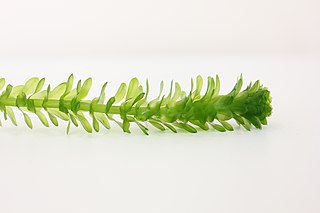
Egeria densa, the large-flowered waterweed or Brazilian waterweed, is a species of Egeria native to warm temperate South America in southeastern Brazil, Argentina, Chile and Uruguay. It is considered a problematic invasive species due to its use in home aquariums and subsequent release into non-native ecosystems.

Buddleja crispa, the Himalayan butterfly bush, is a deciduous shrub native to Afghanistan, Bhutan, North India, Nepal, Pakistan and China, where it grows on dry river beds, slopes with boulders, exposed cliffs, and in thickets, at elevations of 1400–4300 m. Named by Bentham in 1835, B. crispa was introduced to cultivation in 1850, and came to be considered one of the more attractive species within the genus; it ranked 8th out of 57 species and cultivars in a public poll organized by the Center for Applied Nursery Research (CANR) at the University of Georgia, US. In the UK, B. crispa was accorded the Royal Horticultural Society's Award of Merit in 1961. However, the species is not entirely cold-hardy, and thus its popularity is not as ubiquitous as it might otherwise be.
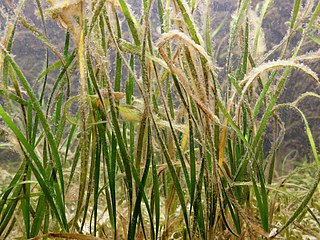
Halodule wrightii is an aquatic plant in the Cymodoceaceae family. It is referred to by the common names shoal grass or shoalweed, and is a plant species native to seacoasts of some of the warmer oceans of the world.

Blyxa is a genus of an aquatic plant of the family Hydrocharitaceae described as a genus in 1806.

Burmannia capitata is a plant species widespread across the West Indies and much of Latin America. It grows in wet areas at elevations less than 100 m. It has been reported from Argentina, Belize, Bolivia, Brazil, Cuba, the Dominican Republic, Haiti, Jamaica, Puerto Rico, Trinidad & Tobago, Colombia, Costa Rica, French Guiana, Guyana, Honduras, southern Mexico, Nicaragua, Panamá, Paraguay, Suriname, Venezuela, and the United States

Limnobium, common names spongeplant and American frogbit, is a group of aquatic plants in the Hydrocharitaceae described as a genus in 1814. It is widespread in freshwater environments in Latin America, the West Indies, and the United States.

Iris hexagona, commonly known as the Dixie iris, is a species in the genus Iris, it is also in the subgenus Limniris and in the series hexagonae. It is a rhizomatous perennial with long bright green leaves, long thin stem and has small groups of flowers in shades of blue, from violet, to bluish purple, to lavender. It flowers in springtime and is native to the southeastern and south-central US states.
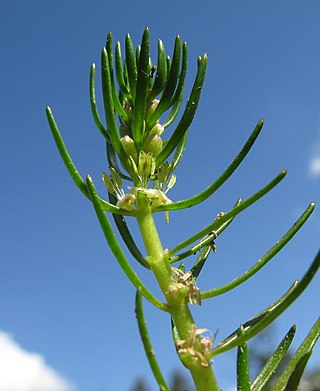
Myriophyllum variifolium is a species of water milfoil native to eastern Australia where it grows in aquatic habitat such as ponds and streams.

Phyllanthus fluitans, also known as the red root floater, floating spurge, or apple duckweed is a species of free floating aquatic plant and herbaceous perennial in the family Phyllanthaceae. This species is one of the only three non-terrestrial species in the genus Phyllanthus, with the other species being P. leonardianus and P. felicis. The generic name comes from Ancient Greek meaning leaf or a leaf flower, and the specific name comes from Latin meaning floating or float. It was described in March 1863 by George Bentham and Johannes Müller Argoviensis.
Blyixa japonica is a species of plant in the family Hydrocharitaceae. It is known as Japanese blyxa or dwarf Asian grass.



















